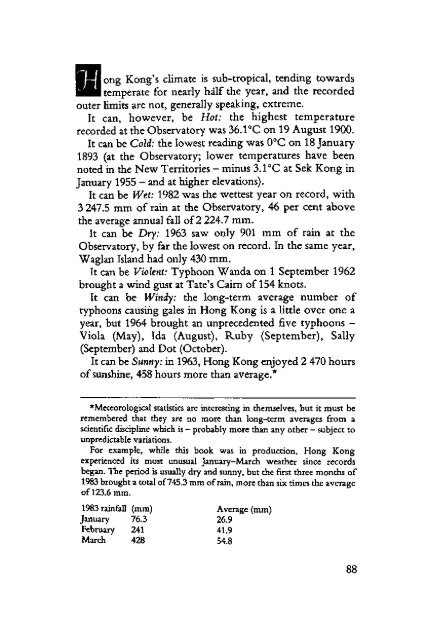Royal - HKU Libraries - The University of Hong Kong
Royal - HKU Libraries - The University of Hong Kong
Royal - HKU Libraries - The University of Hong Kong
Create successful ePaper yourself
Turn your PDF publications into a flip-book with our unique Google optimized e-Paper software.
ong <strong>Kong</strong>'s climate is sub-tropical, tending towardsI temperate for nearly half the year, and the recordedouter limits are not, generally speaking, extreme.It can, however, be Hot: the highest temperaturerecorded at the Observatory was 36.1°C on 19 August 1900.It can be Cold: the lowest reading was 0°C on 18 January1893 (at the Observatory; lower temperatures have beennoted in the New Territories - minus 3.1°C at Sek <strong>Kong</strong> inJanuary 1955 - and at higher elevations).It can be Wet: 1982 was the wettest year on record, with3 247.5 mm <strong>of</strong> rain at the Observatory, 46 per cent abovethe average annual fall <strong>of</strong> 2 224.7 mm.It can be Dry: 1963 saw only 901 mm <strong>of</strong> rain at theObservatory, by far the lowest on record. In the same year,Waglan Island had only 430 mm.It can be Violent: Typhoon Wanda on 1 September 1962brought a wind gust at Tate's Cairn <strong>of</strong> 154 knots.It can be Windy: the long-term average number <strong>of</strong>typhoons causing gales in <strong>Hong</strong> <strong>Kong</strong> is a little over one ayear, but 1964 brought an unprecedented five typhoons -Viola (May), Ida (August), Ruby (September), Sally(September) and Dot (October).It can be Sunny: in 1963, <strong>Hong</strong> <strong>Kong</strong> enjoyed 2 470 hours<strong>of</strong> sunshine, 458 hours more than average.*^Meteorological statistics are interesting in themselves, but it must beremembered that they are no more than long-term averages from ascientific discipline which is ~ probably more than any other - subject tounpredictable variations.For example, while this book was in production, <strong>Hong</strong> <strong>Kong</strong>experienced its most unusual January-March weather since recordsbegan. <strong>The</strong> period is usually dry and sunny, but the first three months <strong>of</strong>1983 brought a total <strong>of</strong> 745.3 mm <strong>of</strong> rain, more than six times the average<strong>of</strong> 123.6mm.1983 rainfall (mm) Average (mm)January 76.3 26.9February 241 41.9March 428 54.888
















